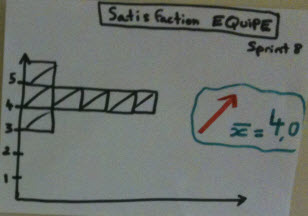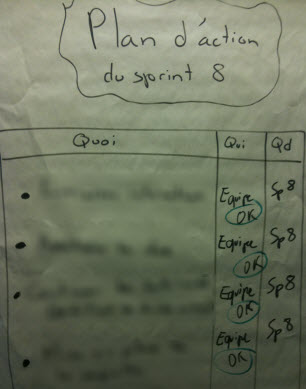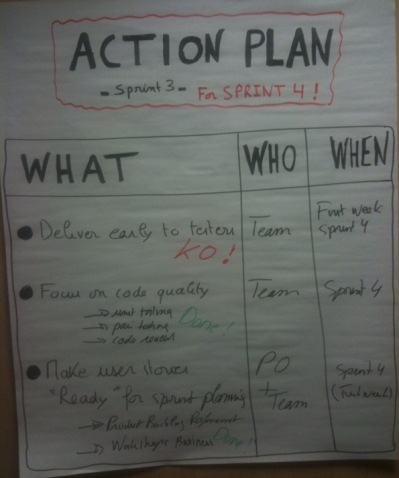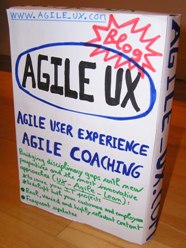Posted by jc-Qualitystreet on 2011/02/21
… the team is now sprint#9, one week before the end of the release.
- All items of the Product Backlog are DONE (except the 5 user stories placed in the « to do » column of the current sprint. These stories are already delivered to internal testers)

Product Backlog: no "To do" items remaining!
- Customer is delighted by the product he has received (incrementally). Very positive feedback sprint after sprint.
- Product quality is good: the application is fast, robust and secure
- Team satisfaction is high (best score)

Team Satisfaction High : "I am glad I’am part of the team and satisfied with how our team works together"
- Trust and transparency are characteristics of the team
- Management satisfaction is high. managers plan to keep the team and to assign it a new product to work on
- Sprint burndown chart of the current sprint is good

A good Burndown Chart !
- Team velocity is good and steady since 4 or 5 sprints
- Team focus factor is high
- Team accuracy of estimation is good
- Action items of the previous action plan are done

Actions items are tracked. Everything was done at the end of the sprint. The poster was displayed on the wall during the sprint.
- Just a few defects in the Bug tracking system
- No impediment

No impediment in the Impediments list
What else?
Just that it was a pleasure to coach such a good team! Thanks you guys.
Posted by jc-Qualitystreet on 2011/02/14
I usually say to Agile teams that the most important outcome of a sprint (or release) retrospective (but also important workshops), is the Action Plan.

Scrum Retrospective Action Plan. A crucial element of facilitation.
Both past and future oriented, the SCRUM retrospective meeting aims to discover what the team did well, understand what went wrong, and to find ways to improve. It’s an important and intense exchange and communication event.
But completing an action plan, at the end of the retrospective, is the only way to make it fully successful and to engage the team in a continuous improvement approach (Inspect & Adapt) for better performance.
Simple
Concise and just enough…
Only a short list of actions (4 max) and three columns that make it simple and effective.
- What (the action: task-oriented, smart and with a verb)
- Who (the owner of the action)
- When (the agreed due-date)
Visual and visible
Build in collaboration on a large sheet of paper. At the end of the meeting, the action plan will join the team’s information radiator, into the team’s workplace to make it visible every day by everybody’s eyes. Communication is crucial for continuous improvement, and visual management is an effective strategy to make the follow up and to maintain engagement.
At the end of the next sprint, actions items of the previous plan will be reviewed: Done or KO…
SMART
Of course, the actions included in the « what » column are SMART:
- Specific
- Measurable
- Achievable
- Realistic
- Time-bound
Then, I like to get the team’s commitment to the plan before closing the meeting and doing the ROTI (Return On Time Invested).
Posted by jc-Qualitystreet on 2010/03/30
Agile Coach vs ScrumMaster: it is sometimes a bit blurry … probably because the ScrumMaster acts sometimes as an agile coach, using coaching techniques and probably because the Agile coach is sometimes asked to play the role of ScrumMaster in Scrum projects.
But according to me: « The ScrumMaster is not an Agile Coach » … here are some elements of comparison:
|
AGILE COACH
|
ScrumMaster
|
| Mission |
High variability. Never the same.
For a person and / or a Team and /or an Organization
A strong clarification of the objectives and a precise analysis of the context are required.
For this journey toward agility, concrete and measurable result should be defined. |
Little variability. Often the same
For the team
Objectives are usually unambiguous, related to a well defined role description:
– Ensuring that the team is fully functional and productive,
– Ensuring that the Scrum process is followed in terms of values, practices and rules
– Enabling close collaboration
– Protecting the team,
– Removing Impediments
|
| Scope |
Agility (broader) and Change |
Scrum |
| Link with the Project |
The agile coach is not involved in the project (independent) |
The ScrumMaster is involved in the project |
| Link with the team |
Not part of the team
Does not protect the team |
With the team daily
Protects the team |
| Activity – Presence |
Variable and not continuous depending on the context and needs. Stronger presence at the beginning of the mission, less thereafter. The Coach is looking for the autonomy of his client … |
Continuous. Throughout the project period. |
| Training |
Trained in methods, roles and Agile practices.
Trained in coaching (certified or not)
Good knowledge of IT projects life cycles, roles, actors and activities
Basic knowledge of psychology |
Trained in the role of ScrumMaster (certified or not) |
| Experience in agility (depth … Years of experience.) |
Required |
Not necessary |
| Experience in agility (width … Implementation in various contexts, with multiple teams) |
Required |
Not necessary |
| Acts as a Trainer |
+ + + |
No |
| Acts as a Facilitator |
+ + |
+ + + |
| Acts as a Mentor |
+ + + |
+ |
| Acts as a Coach |
+ + + |
+ |
| Acts as a Consultant |
+ |
No |
| Is the agent of change |
+ + + |
+ |
Scale: +++ (Yes Very Much) ; ++ (Yes Much) ; + (Yes Little) ; No
It’s my Vision, what’s yours ?







